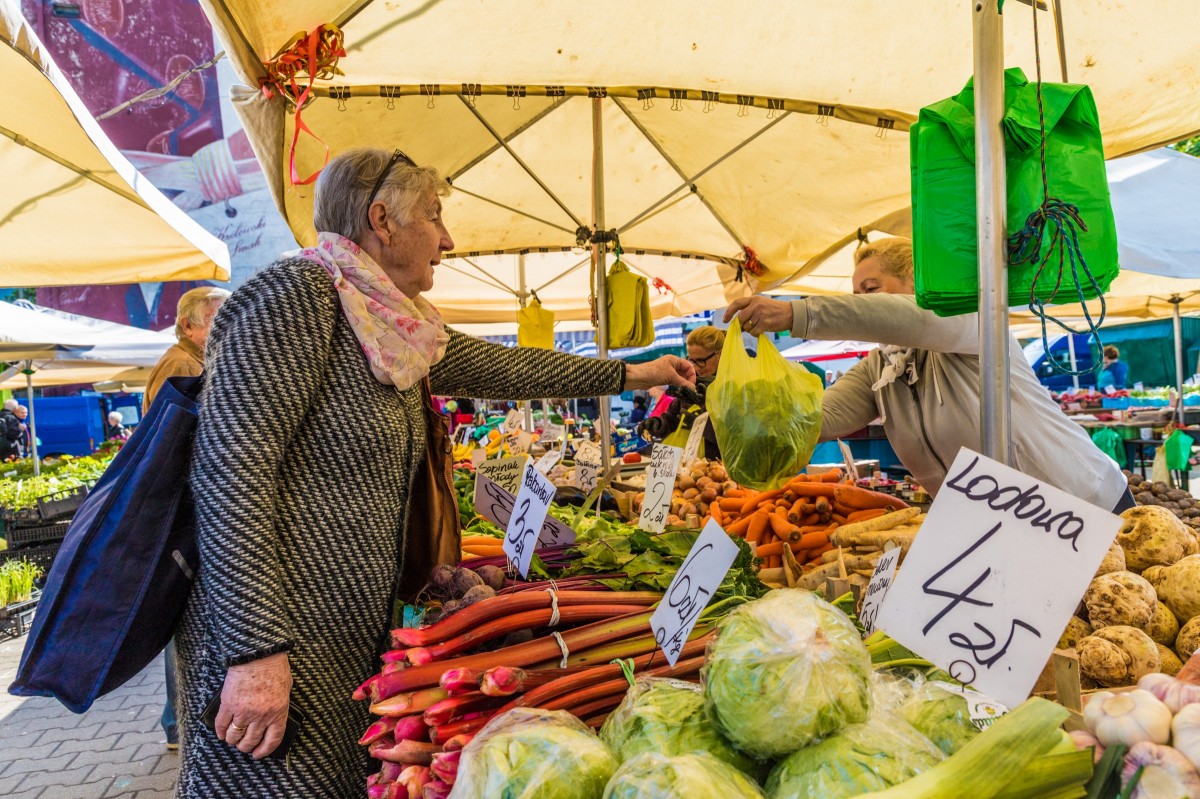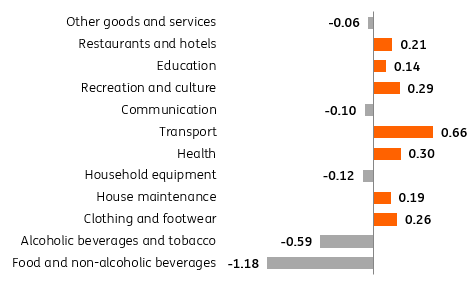Tuesday, March 15, 2022 1:52 PM EST
Consumer inflation moderated to 8.5% year-on-year in February as new elements of the anti-inflation shield kicked in, but it is set to rise to 10% year-on-year in March amid upward pressure from gasoline and food prices. CPI inflation may average 10% in 2022 despite government measures to tame it.

In February, Poland cut the VAT on food, natural gas, electricity and central heating to zero
Consumer Price Index (CPI) inflation fell to 8.5% year-on-year in February (ING: 7.9%; consensus: 8.3% year-on-year) from 9.4% year-on-year in January (revised upwards from 9.2% year-on-year) and 8.6% year-on-year in December 2021. Price growth moderated because of new anti-inflation shield measures. In February, Poland cut the VAT on food, natural gas, electricity and central heating to zero. The VAT rate on gasoline and diesel went down from 23% to 8%. The anti-inflation shield triggered declines in food prices (1.1% month-on-month), energy for housing (1.2% month-on-month) and fuel at the pumps (8.1% month-on-month). Increases in electricity and central heating in monthly terms came as a surprise given cuts in VAT to 0%.
The March inflation report is always accompanied by an annual update of CPI basket weights. According to the StatOffice, the share of food declined – having risen during the pandemic – as consumers did not eat at home as often as they did during the pandemic lockdowns. At the same time, households spent more on services, namely transport as well as hospitality and leisure as mobility improved. The share of expenditure on house maintenance also increased slightly. Taking into account new basket weights, we estimate that core inflation excluding food and energy prices increased to 6.7% in February from 6.2% in January and 5.3% in December.
Changes to CPI basket weights, percentage points

The outbreak of the war in Ukraine has resulted in upward pressure on commodities, including energy and food. The new pro-inflationary factors largely compensate for the anti-inflation shields. We expect CPI to reach around 10% year-on-year in March. Assuming the shields are extended for the whole year, 2022 CPI should average around 10% year-on-year. In 2023, inflation should be only marginally lower, depending on political decisions about when to withdraw lower indirect tax rates introduced this year.
The prospect of a prolonged period of elevated inflation suggests that the ongoing rate hike cycle will continue. In 2022 we see the reference rate rising above 5%. Next year we expect further hikes amid a new wave of fiscal spending, both domestically and across Europe.
Disclaimer: This publication has been prepared by the Economic and Financial Analysis Division of ING Bank N.V. (“ING”) solely for information purposes without regard to any ...
more
Disclaimer: This publication has been prepared by the Economic and Financial Analysis Division of ING Bank N.V. (“ING”) solely for information purposes without regard to any particular user's investment objectives, financial situation, or means. ING forms part of ING Group (being for this purpose ING Group NV and its subsidiary and affiliated companies). The information in the publication is not an investment recommendation and it is not investment, legal or tax advice or an offer or solicitation to purchase or sell any financial instrument. Reasonable care has been taken to ensure that this publication is not untrue or misleading when published, but ING does not represent that it is accurate or complete. ING does not accept any liability for any direct, indirect or consequential loss arising from any use of this publication. Unless otherwise stated, any views, forecasts, or estimates are solely those of the author(s), as of the date of the publication and are subject to change without notice.
The distribution of this publication may be restricted by law or regulation in different jurisdictions and persons into whose possession this publication comes should inform themselves about, and observe, such restrictions.
Copyright and database rights protection exists in this report and it may not be reproduced, distributed or published by any person for any purpose without the prior express consent of ING. All rights are reserved. ING Bank N.V. is authorised by the Dutch Central Bank and supervised by the European Central Bank (ECB), the Dutch Central Bank (DNB) and the Dutch Authority for the Financial Markets (AFM). ING Bank N.V. is incorporated in the Netherlands (Trade Register no. 33031431 Amsterdam). In the United Kingdom this information is approved and/or communicated by ING Bank N.V., London Branch. ING Bank N.V., London Branch is deemed authorised by the Prudential Regulation Authority and is subject to regulation by the Financial Conduct Authority and limited regulation by the Prudential Regulation Authority. The nature and extent of consumer protections may differ from those for firms based in the UK. Details of the Temporary Permissions Regime, which allows EEA-based firms to operate in the UK for a limited period while seeking full authorisation, are available on the Financial Conduct Authority’s website.. ING Bank N.V., London branch is registered in England (Registration number BR000341) at 8-10 Moorgate, London EC2 6DA. For US Investors: Any person wishing to discuss this report or effect transactions in any security discussed herein should contact ING Financial Markets LLC, which is a member of the NYSE, FINRA and SIPC and part of ING, and which has accepted responsibility for the distribution of this report in the United States under applicable requirements.
less
How did you like this article? Let us know so we can better customize your reading experience.




